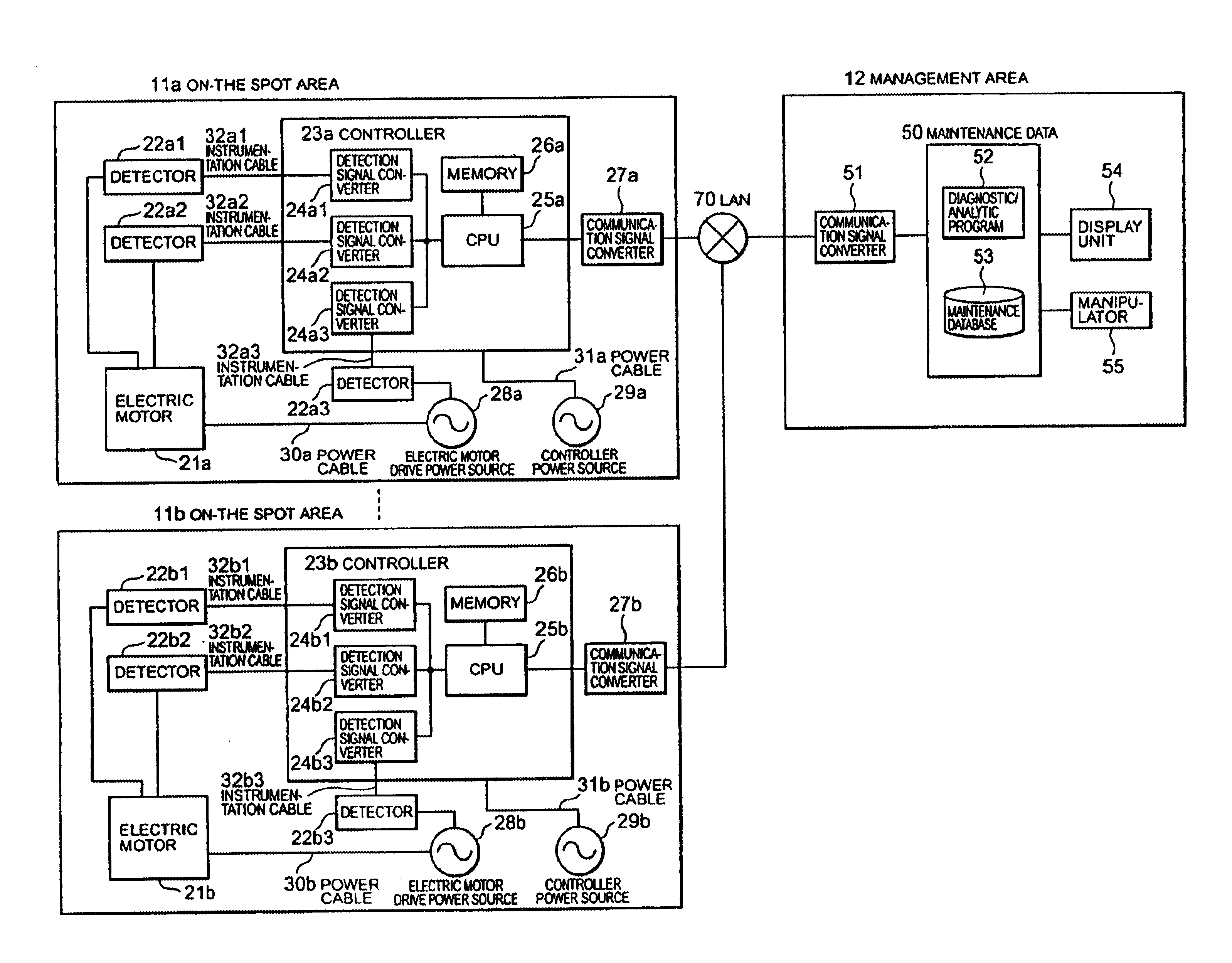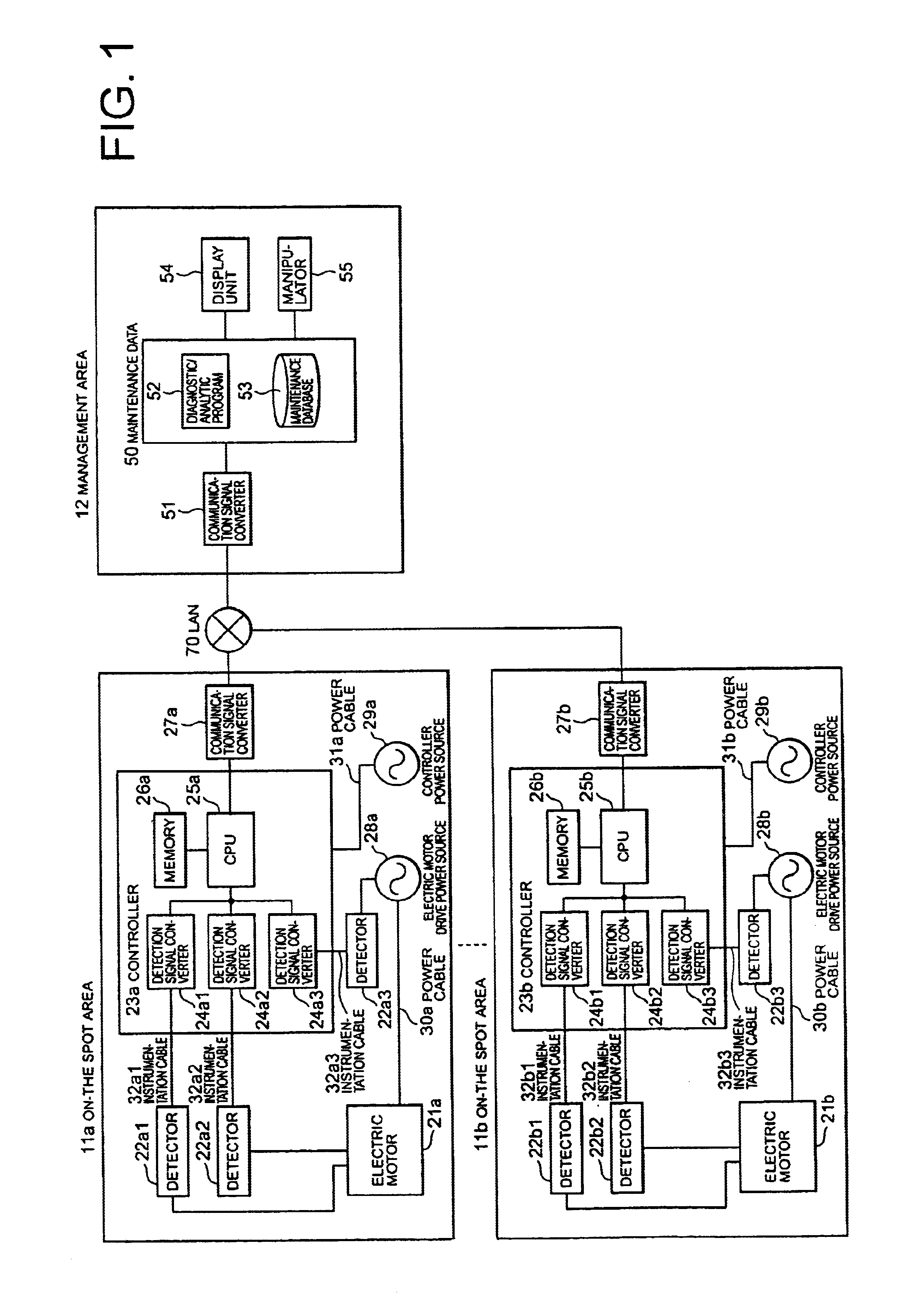State-of-device remote monitoring system
a monitoring system and state-of-device technology, applied in the direction of electric controllers, program control, instruments, etc., can solve the problems of cost of introducing the cable, the inability to realistically do the man-based process, and the difficulty of extending the new cabl
- Summary
- Abstract
- Description
- Claims
- Application Information
AI Technical Summary
Benefits of technology
Problems solved by technology
Method used
Image
Examples
embodiment 1
FIG. 1 is a diagram showing an architecture of a state-of-device remote monitor system in accordance with the present invention. FIG. 2 is a flowchart showing an operation in Embodiment 1.
As shown in FIG. 1, the architecture in Embodiment 1 is configured by a single or a plurality of on-the-spot areas 11a, 11b and a management area 12 existing at some distance from the on-the-spot areas 11a, 11b.
In the on-the-spot area 11a, an electric motor 21a is supplied with the electricity via a power cable 30a from a power source 28a. States of the electric motor 21a and the power source 28a are detected by a plurality of detectors 22a1, 22a2, 22a3 attached thereto, and detection signals thereof are transmitted to a controller 23a via instrumentation cables 32a1, 32a2, 32a3.
Detection signal converters 24a1, 24a2, 24a3 convert the signals transmitted via these instrumentation cables 32a1, 32a2, 32a3 into digital signals that can be processed by a CPU 25a. The detection signals and instructions...
embodiment 2
FIG. 3 illustrates an embodiment different from Embodiment 1. According to Embodiment 1, the data transmission between the on-the-spot area 11a and the management area 12 involves applying the LAN 70. According to Embodiment 2, however, as shown in FIG. 3, the data transmission between the on-the-spot area 11a and the management area 12 involves applying a radio system.
In Embodiment 2, a hardware architecture between the controller 23a and the maintenance tool 50 is different from that in Embodiment 1, and is configured by a radio signal converter 33a for converting the detection data outputted from the controller 23a in the on-the-spot area 11a into radio signals, and a radio signal converter 56 for converting the radio signals in the management area 12 into data signals in the management area 12.
The discussion will be focused on a different system operation of the state-of-device remote monitor system in Embodiment 2 from Embodiment 1. The detection data obtained from all the dete...
embodiment 3
FIG. 5 shows an embodiment different from Embodiments 1 and 2. According to Embodiments 1 and 2, the data transmission between the on-the-spot area 11a and the management area 12 involves applying the LAN 70 and the radio 71. In Embodiment 3, however, the data transmission involves applying, as shown in FIG. 5, a public telephone line 73.
A different architecture in Embodiment 3 from Embodiment 1 is provided between the controller 23a and the maintenance tool 50, and is configured by a router 34a for transferring the signals outputted from the controller 23a in the on-the-spot area 11a to the telephone line 73, and a router 57 for transferring the signals from the telephone line 73 to the maintenance tool 50 in the management area 12. Note that the telephone line 73 is a part of the existing infrastructures.
If the telephone line is not connected, a connection of the telephone line is established by dial-up accesses of the routers 34a and 57. Further, if the telephone line is classifi...
PUM
 Login to View More
Login to View More Abstract
Description
Claims
Application Information
 Login to View More
Login to View More - R&D
- Intellectual Property
- Life Sciences
- Materials
- Tech Scout
- Unparalleled Data Quality
- Higher Quality Content
- 60% Fewer Hallucinations
Browse by: Latest US Patents, China's latest patents, Technical Efficacy Thesaurus, Application Domain, Technology Topic, Popular Technical Reports.
© 2025 PatSnap. All rights reserved.Legal|Privacy policy|Modern Slavery Act Transparency Statement|Sitemap|About US| Contact US: help@patsnap.com



